Lawn Seeding
Elite Lawn is a blend of turf quality Bluegrasses, Perennial Rye grass, and creeping red fescue. Elite lawn is a cool season perennial ground cover forming a beautiful, high quality, dense sod. An excellent lawn planting choi
H2O Saver is a blend of improved fine fescue grasses. Fescue grasses are specifically blended to create a high drought tolerant blend that keeps a bright green color with minimal need for H2O. H2O Saver is a popular choice for areas that need to look good with minimal maintenance.
Bluegrass grows by roots from single plants and at the same time sends out stems to form their own roots. This interweaves and supports the base making it denser as it grows. Less moisture can be lost this way to evaporation than with the more "open" growing plants with ground and air space between the plants themselves. This is why this grass falls into the creeping grass category.
Additions of creeping red fescue, perennial rye grass or annual rye grass seeds are included in bluegrass for several reasons. Red Fescue tolerates shadier areas where bluegrass may not get enough sunshine. Annual rye grass is often seeded with the bluegrass to achieve green-up earlier and dies off when warmer weather sets in.
The addition of perennial ryegrass helps to develop a tougher sod that stands up to tougher wear. Bluegrass and perennial rye are good companion grasses for athletic fields and playgrounds. These different combinations of grass seeds works exceedingly well for newly planted seedbeds and over seeding existing stands of bluegrass lawns. The balanced mix is chosen to utilize the specialties derived per each kind; blending traits to produce the best composite coverage possible. Including the faster growing Ryegrass also produces a lawn cover while the Bluegrass grows in.
Healthy Lawn Care Tips
Early Spring Lawn Care
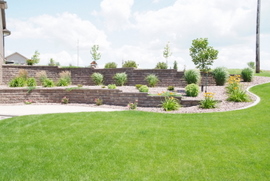
- Keep off the lawn in the spring until the ground has dried and is firm to walk on.
- Rake up debris, dead grass, leaves, etc.
- Roll "frost bumps" with a light roller.
- Aerate the lawn annually in high traffic areas, every other year is usually sufficient in low use areas.
- Apply a 30-5-5 lawn fertilizer.
Late Spring
- Apply grass seed to repair damaged areas or thicken an existing lawn*
- Apply 21-7-7 lawn fertilizer.
- Follow mowing suggestions listed below.
- If lawn weeds are a problem see FAQ's Info Below
Summer Lawn Care
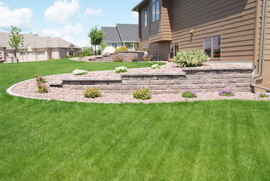
- Follow watering and mowing suggestions listed below.
- Apply 16-8-8 lawn fertilizer.
- If insects are a problem see FAQ's Info Below
Fall Lawn Care
- Fall is the best time to apply grass seed to repair damaged areas or thicken existing lawn*
- Follow watering and mowing suggestions listed below.
- Apply 21-7-7 a premium winterizing fertilizer.
- If lawn weeds are a problem see FAQ's Info Below
*Grass seed germination is not compatible with weed control products used on lawns. They cannot be applied with in 6 weeks of each other. As a general rule - seed in the spring and weed in the fall or weed in the spring and seed in the fall.
Watering
- Most lawns require a minimum of 2.5cm (1") of water per week during the summer.
- In dry conditions, water heavily once a week as opposed to a daily sprinkling (daily sprinkling encourages shallow roots, which will increase the chance of burn during hot spells)
- Try to wet the entire root zone.
- Do not water at night – the chance of fungus developing is increased.
- Use a rain gauge or aluminum pie plate to measure if the correct amount of water is being applied.
Mowing
- Ensure mower blade is sharp to prevent frayed appearance.
- Mow to 5cm to 7.5cm (2"-3") in spring and fall
- Raise mower another 1cm (½") during hot weather to improve drought resistance.
- Never remove more than 1/3rd of the grass blade at one mowing.
- Change direction of the cut each time to keep coarse grasses under control and ensure an even surface.
Aeration
- Aeration will increase the amount of air, water and nutrients getting to the soil, which will strengthen grass roots and help create a healthier lawn.
- Aeration should be done annually in high traffic areas.
- Aeration before an application of fertilizer will allow nutrients easier access to root systems.
Fertilizer Application
- Read the complete label before using.
- Remove debris, toys, etc from the lawn.
- Use a good broadcast spreader with an accurate flow setting.
- Wash and lubricate spreader after use.
- Fill the spreader on the drive or walk and not on the lawn.
- Sweep up spilt fertilizer.
- Shut off the spreader when stopping or turning.
- Apply half of the required fertilizer in one direction on the lawn (i.e. north/south). Apply the remaining fertilizer across the lawn (i.e. east/west). This will help to provide even coverage and prevent streaking from missed spots and overlap.
- Do not apply Weed & Feed when rain is expected.
- Do not water the lawn for 48 hours after applying Weed & Feed
- Store any remaining fertilizer in a cool dry place.
- Wash after using fertilizer.
Frequently Asked Questions about grass seed.
How long does it take for grass seed to germinate?
- Depending on mixture, you should expect initial growth for most varieties to begin in 7 days provided adequate moisture is available, soil is warm enough and conditions allow for germination.
- Kentucky Bluegrass will take up to 30 days to germinate.
- The more ryegrass in the mix the faster the grass will establish.
- The more bluegrass in the mix the slower the grass will establish.
- First mowing should take place when the lawn is thick and the grass blades reach 3" in height.
Should I seed or lay sod?
Before you start, you may question whether to use seed or sod. Both options have advantages, which need to be weighed.
Seeding
| Pros: |
Cons: |
- Cost - Seeding a lawn is a fraction of the cost compared to sod.
- Customization - Seeding allows you to use different blends for different areas on your property (sun, shade, etc.). Personal satisfaction is another factor. Seeing a lawn germinate from seed and fill into a lush stand of turf gives the same sense of accomplishment one feels from raising vegetables in a garden or preparing a spectacular meal from scratch.
|
- It takes 8-12 weeks for a new lawn to fully establish. During this time you want little to no traffic on it. You'll also need to keep the ground moist through most of this period. It is also susceptible to invasion by weeds during this establishment time.
|
Sod
| Pros: |
Cons: |
- Sod is an instant lawn. One day bare ground, the next day a fully-grown lawn. It's hard to beat that.
- Most sod growers are experienced, professional turf grass managers. They produce a high quality product and use improved varieties that aren't readily available in the retail market.
|
- Cost is the biggest factor here. For many people, sod isn't in their budget.
|
When is the best time to seed?
- Best time to seed is late summer – early fall.
- The exact timing will vary from location to location and from year to year.
- The hot days of summer should be past before seeding.
- Fall seeding allows two establishment periods (fall and spring) before the grass must go through a hot, dry summer.
- Soil temperatures are warm to promote fast germination and the nights are cool.
- Increased morning dew helps keep seeds moist.
- Reduced pressure from competitive weeds.
Can I seed in the Spring?
- Yes, apply seed in Spring when soil temperature reaches 15°C (60°F) - Ideally mid May to mid June. If you have spread grass seed in the early spring, it will not germinate until the soil temperature reaches about 15°C (about 59°F).
What can I do about weeds in my lawn?
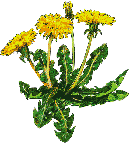
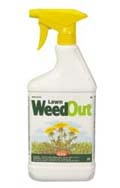
- The best defense against lawn weeds is a thick healthy lawn. If you choose to use a pest control product always read the label and follow all directions and precautions.
- If weeds are a problem consider the following guide*
- A few weeds in the lawn? - Dig by hand; ensure you remove the entire root.
- Many weeds scattered throughout the lawn? - Use Lawn WeedOut® Ready-To-Use to spray the individual weeds.
- Many weeds in few areas of the lawn? - Use Lawn WeedOut® Attach & Spray or Lawn WeedOut® Concentrate to spray the area.
- Many weeds over the entire lawn? - Use Lawn WeedOut® Attach & Spray or Lawn WeedOut® concentrate or use a premium slow release lawn fertilizer with weed control (in place of a regular fertilizer application) to treat the entire lawn
*Grass seed germination is not compatible with weed control products used on lawns. They cannot be applied within 6 weeks of each other. As a general rule - seed in the spring and weed in the fall or weed in the spring and seed in the fall.
What can I do about lawn insects?
Here is some information about the common lawn insect pests. The best defense against insect damage is a thick healthy lawn. If you choose to use a pest control product always read the label and follow all directions and precautions
Grubs
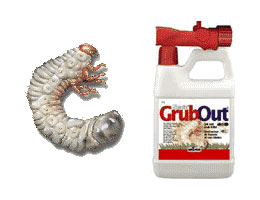 Grubs feed on the roots of the grass. Damage is identified as dead grass that can be lifted like a piece of carpet. Grub damage is usually first noticed in mid- to late August; damage will first occur in the sunniest, driest locations of the lawn and can spread very quickly during dry conditions. To check for grubs, cut and turn over a 1 ft square section of grass at the edge of a brown area. Grubs will be found within the top couple cm of soil. The grubs are milky white with a brown head and a darker tail. They will be curled up in a "C" shape and may be up to 1.7 cm (3/4 inch) long. 5 or more grubs in a square foot can cause damage to the lawn and treatment should be considered. For good grub control it is important to follow all of the following steps.
Grubs feed on the roots of the grass. Damage is identified as dead grass that can be lifted like a piece of carpet. Grub damage is usually first noticed in mid- to late August; damage will first occur in the sunniest, driest locations of the lawn and can spread very quickly during dry conditions. To check for grubs, cut and turn over a 1 ft square section of grass at the edge of a brown area. Grubs will be found within the top couple cm of soil. The grubs are milky white with a brown head and a darker tail. They will be curled up in a "C" shape and may be up to 1.7 cm (3/4 inch) long. 5 or more grubs in a square foot can cause damage to the lawn and treatment should be considered. For good grub control it is important to follow all of the following steps.
- Remove as much of the thatch as possible with a heavy raking.
- Pre-soak the lawn with water. Ensure that the soil is wet down to the grass root zone
- Apply GrubOut®. Follow the label directions for application rates and coverage.
- Water-in to rinse the GrubOut® off the grass blades and into the soil
Chinch Bugs
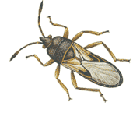 Chinch Bugs can cause severe damage to lawns. The Chinch Bug sucks the juices out of the blades of grass causing the lawn to turn yellowish brown, dry up and die. The damage will first be noticed in dry sunny areas and spread out in irregular patches. They attack the grass in mid to late summer usually during dry conditions. To check for Chinch Bugs, remove both ends of a large can and press it 3-5 cm into the ground at the edge of a brown patch. Fill the can with water and keep it filled for 10 minutes. Chinch Bugs will float to the surface. They are black to brown insects with white on their wings, approximately 3-5 mm (1/8 ") long. Apply GrubOut® as damage is noticed. A second application in 14 days is often required. Grass seed varieties that contain endophyte can help reduce damage caused by Chinch Bugs.
Chinch Bugs can cause severe damage to lawns. The Chinch Bug sucks the juices out of the blades of grass causing the lawn to turn yellowish brown, dry up and die. The damage will first be noticed in dry sunny areas and spread out in irregular patches. They attack the grass in mid to late summer usually during dry conditions. To check for Chinch Bugs, remove both ends of a large can and press it 3-5 cm into the ground at the edge of a brown patch. Fill the can with water and keep it filled for 10 minutes. Chinch Bugs will float to the surface. They are black to brown insects with white on their wings, approximately 3-5 mm (1/8 ") long. Apply GrubOut® as damage is noticed. A second application in 14 days is often required. Grass seed varieties that contain endophyte can help reduce damage caused by Chinch Bugs.
Ants
Ants are more of a nuisance than a serious lawn pest. Anthills and their tunneling can damage your lawn by smothering the grass and drying out the soil. Ants in your lawn left unchecked will find their way into the house. Long-term control of ants can only be achieved by destroying the nest. Apply GrubOut® directly to the anthills and water in. For more complete control over a larger area, spray the entire lawn, gardens, patio and around the house with special attention to anthills and trails.
Sod Webworm
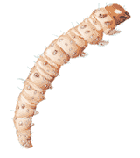 Sod Webworm, the larvae of Lawn Moths feed on the blades of grass, chewing them off at ground level. Damage will appear as irregular brown patches scattered in the driest area of the lawn. If left unchecked these patches become larger and the entire lawn can be destroyed. Dead grass will pull away in clumps. The larva are dirty white in color with a dark brown head and rows of dark spots on their back. They live in silky tubes near the roots. The adults are small light colored moths that fly up from the lawn in the evening when they are disturbed. Damage usually appears in late August and September. Apply GrubOut® when damage is first noticed or when moths are plentiful. For best results apply in the afternoon or evening to a moist lawn. Grass seed varieties that contain endophyte can help reduce damage caused by Sod webworms.
Sod Webworm, the larvae of Lawn Moths feed on the blades of grass, chewing them off at ground level. Damage will appear as irregular brown patches scattered in the driest area of the lawn. If left unchecked these patches become larger and the entire lawn can be destroyed. Dead grass will pull away in clumps. The larva are dirty white in color with a dark brown head and rows of dark spots on their back. They live in silky tubes near the roots. The adults are small light colored moths that fly up from the lawn in the evening when they are disturbed. Damage usually appears in late August and September. Apply GrubOut® when damage is first noticed or when moths are plentiful. For best results apply in the afternoon or evening to a moist lawn. Grass seed varieties that contain endophyte can help reduce damage caused by Sod webworms.
Cranefly Larva
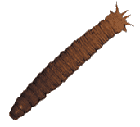 The adult Crane Fly looks like a large mosquito. The larvae, called leatherjackets, feed on the grass in the fall and spring. The worst damage is done in March and April. By mid June leather jackets stop feeding and move deeper into the soil to pupate. Leatherjackets are found just under the surface of the soil. Cut and roll back the sod to check for leatherjackets. The regions hardest hit with leatherjacket damage are Southern ON, BC, Nova Scotia. The domestic product registered for leatherjacket control at this time is Diazinon. Commercial applicators are using Sevin and Diazinon.
The adult Crane Fly looks like a large mosquito. The larvae, called leatherjackets, feed on the grass in the fall and spring. The worst damage is done in March and April. By mid June leather jackets stop feeding and move deeper into the soil to pupate. Leatherjackets are found just under the surface of the soil. Cut and roll back the sod to check for leatherjackets. The regions hardest hit with leatherjacket damage are Southern ON, BC, Nova Scotia. The domestic product registered for leatherjacket control at this time is Diazinon. Commercial applicators are using Sevin and Diazinon.
What is the best choice for erosion control?
On steep slopes, where erosion is likely to be a problem, select a ground cover that will root firmly to hold the soil in place. From the mid US to northern Canada, one of the best species for erosion control is crown vetch. It is best grown in sunny, well drained areas. It is very winter and drought hardy. It is also a legume like clover so it will fix its own nitrogen. Crown vetch blooms prolifically with pinkish purple flowers. Once established, the site will explode into color each summer.
The main drawback to crown vetch is that it is very slow to establish. In the first year, you barely be able to see any. In the second year it will start to show. However once it is established, it will be very aggressive and over the next few years will likely colonize the entire area that you planted.
Because of its slow start, crown vetch is best seeded with a cover grass. A mix of ryegrass (perennial or annual) and creeping red fescue works well. These grasses will hold the ground while the vetch first establishes and then eventually takes over.